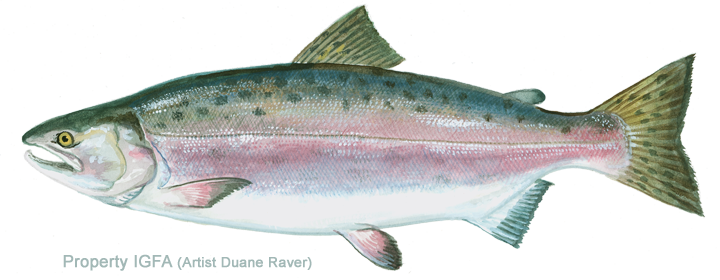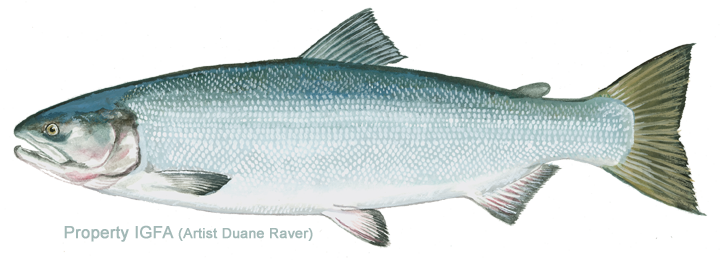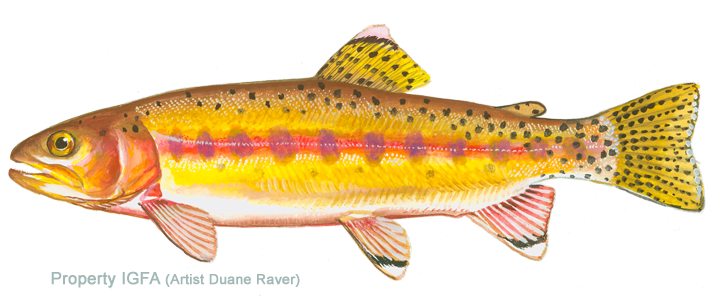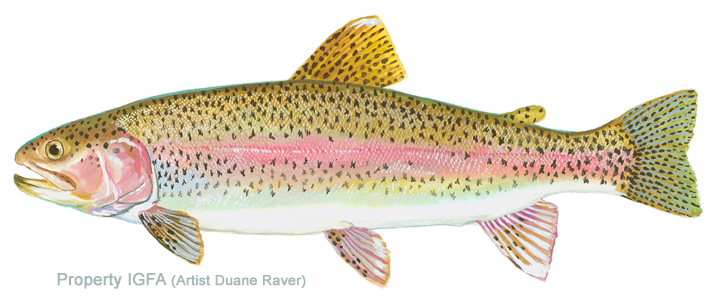Game Fish Identification Reference Guides
Salmon, chum
(Oncorhynchus keta)
(Oncorhynchus keta)
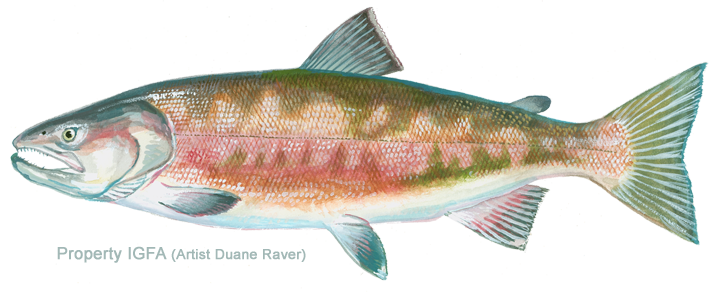
(Walbaum, 1792), SALMONIDAE FAMILY; also called dog salmon, fall salmon, autumn salmon
Endemic to the Pacific and Arctic Oceans, the Bering Sea, the Sea of Japan, and the Okhotsk Sea. In North America it occurs from the San Lorenzo River, California, to northwest Alaska, and east to the Peel, MacKenzie and possibly Anderson Rivers. During spawning it is known to ascend some rivers for considerable distances 1,242 mi or (2,000 km). In the MacKenzie River, N.W.T., Canada, it travels all the way to the mouth of the Hay River and to the rapids below Forth Smith on the Salve River, entering both Great Bear and Great Slave Lakes and traveling through the Northwest Territories to the edge of Alberta. Like all Pacific salmons, with the exception of landlocked specimens, the chum salmon is anadromous.
At sea, it is silvery and has no distinct black spots, though it may have fine black speckling on the upper sides and back. Spawning males turn olive green with blood red vertical markings reaching up the sides, making this one of the most easily recognized Pacific salmon species. The color of spawning females is less vivid, but essentially the same. Breeding males of the species have large, bared teeth, which may be the origin of the name “dog salmon,” though it is also said that this name evolved because this species was often fed to sled dogs.
The flesh is creamy white and the lowest of all the salmons in fat content. It is not as popular or as desirable as other Pacific salmons.
Together with the pink salmon, Oncorhynchus gorbuscha, it is sometimes called “autumn salmon” or “fall salmon” because it is the last salmon to make its spawning run. It begins entering the river mouths after mid June and reaches some spawning grounds as late as November or December. This late run severely affects its utilization as a sport fish, and it is not one of the most sought after by anglers
Endemic to the Pacific and Arctic Oceans, the Bering Sea, the Sea of Japan, and the Okhotsk Sea. In North America it occurs from the San Lorenzo River, California, to northwest Alaska, and east to the Peel, MacKenzie and possibly Anderson Rivers. During spawning it is known to ascend some rivers for considerable distances 1,242 mi or (2,000 km). In the MacKenzie River, N.W.T., Canada, it travels all the way to the mouth of the Hay River and to the rapids below Forth Smith on the Salve River, entering both Great Bear and Great Slave Lakes and traveling through the Northwest Territories to the edge of Alberta. Like all Pacific salmons, with the exception of landlocked specimens, the chum salmon is anadromous.
At sea, it is silvery and has no distinct black spots, though it may have fine black speckling on the upper sides and back. Spawning males turn olive green with blood red vertical markings reaching up the sides, making this one of the most easily recognized Pacific salmon species. The color of spawning females is less vivid, but essentially the same. Breeding males of the species have large, bared teeth, which may be the origin of the name “dog salmon,” though it is also said that this name evolved because this species was often fed to sled dogs.
The flesh is creamy white and the lowest of all the salmons in fat content. It is not as popular or as desirable as other Pacific salmons.
Together with the pink salmon, Oncorhynchus gorbuscha, it is sometimes called “autumn salmon” or “fall salmon” because it is the last salmon to make its spawning run. It begins entering the river mouths after mid June and reaches some spawning grounds as late as November or December. This late run severely affects its utilization as a sport fish, and it is not one of the most sought after by anglers
















